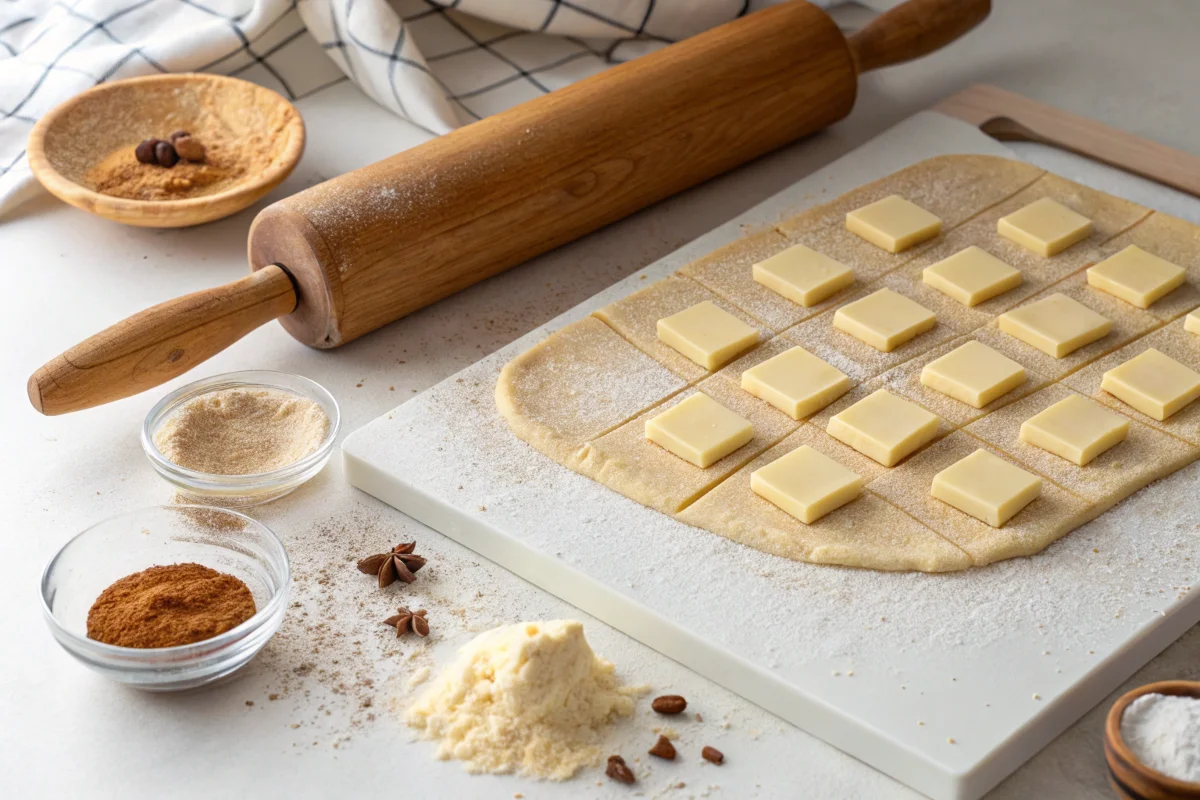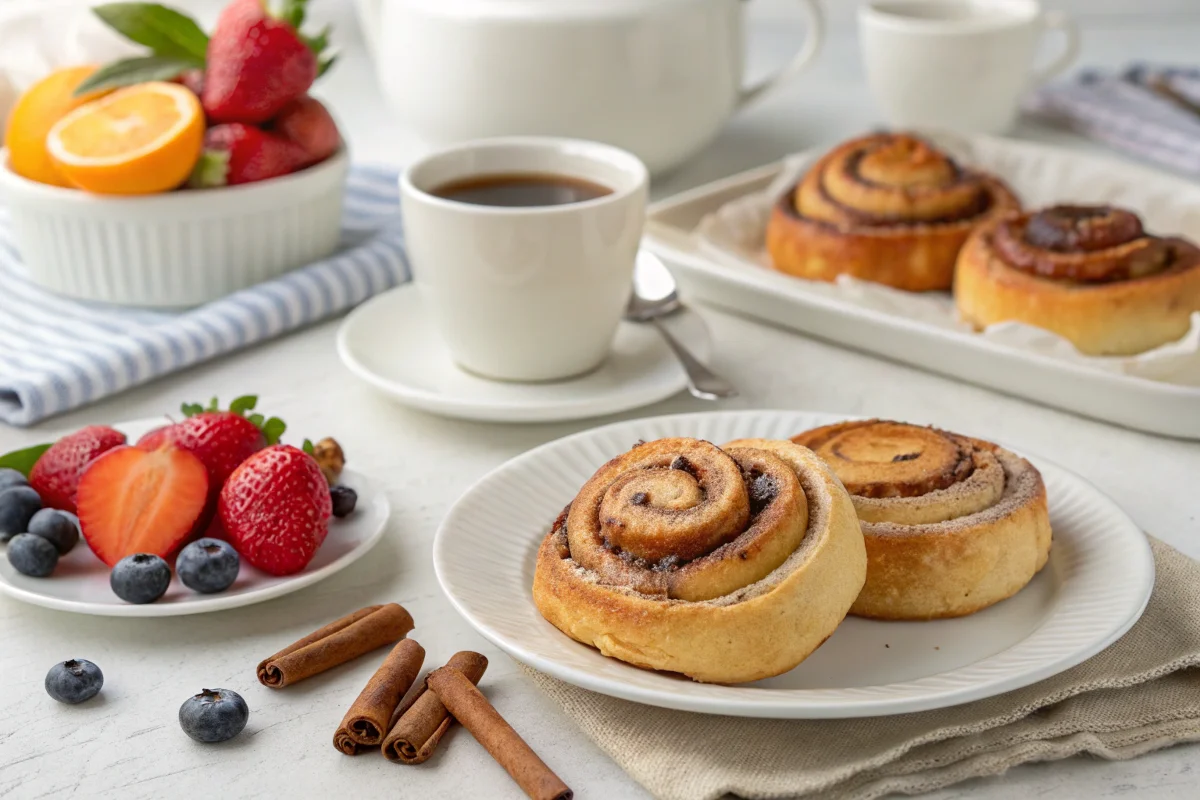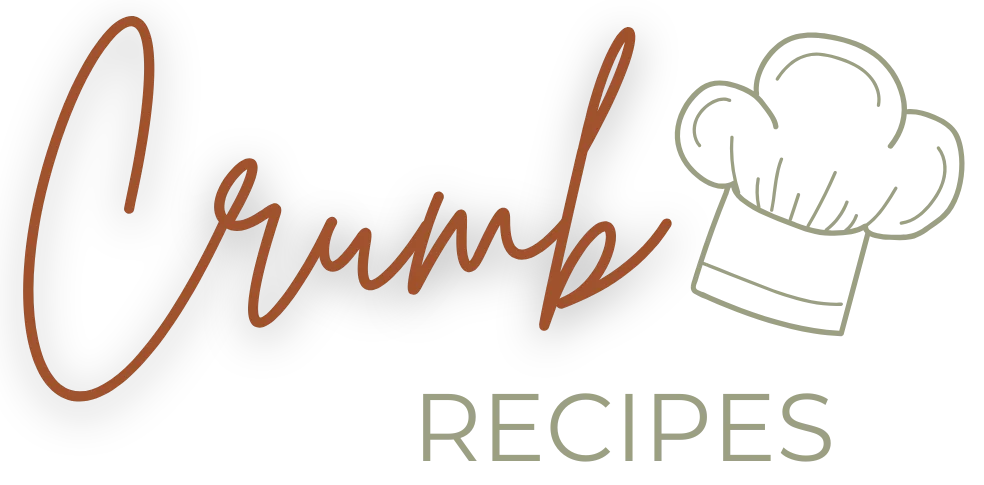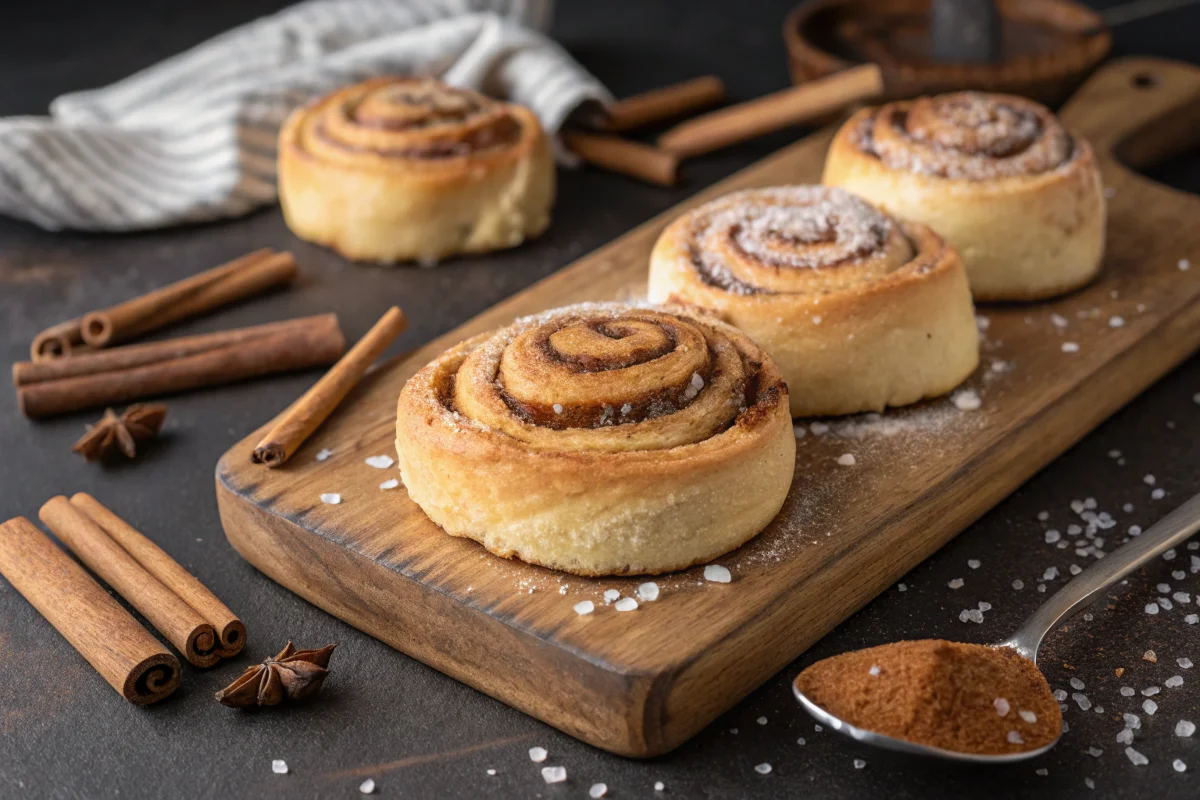When you think of a perfect morning pastry, you might picture flaky layers and sweet spices. However, many traditional treats feel predictable. Kouign amann cinnamon buns offer a new twist that breaks the mold. They combine the buttery richness of a Breton pastry with the warm, comforting flavor of cinnamon rolls. In addition, these buns taste decadent yet balanced, making them a memorable choice.
This pastry marries two classics: the traditional kouign-amann, known for its caramelized sugar and laminated dough, and the familiar cinnamon bun, prized for its soft, warm swirl of cinnamon filling. Early morning cravings often center on sweet treats that melt in your mouth. Therefore, introducing a pastry that blends complexity and comfort sets a tone worth savoring. For context, you can learn more about kouign amann cinnamon buns by checking out the Wikipedia article on Kouign-Amann.
Why Choose Kouign Amann Cinnamon Buns?
In many bakeries, you find either a croissant-like pastry or a cinnamon roll. However, it’s rare to see these two traditions combined. The French kouign-amann hails from Brittany, where bakers fold butter and sugar into dough. This technique creates caramelized layers that crackle beneath your teeth. Meanwhile, cinnamon buns have roots in Northern Europe. Their iconic spiral and heady spice aroma remain beloved around the globe.
Many pastry fans crave something different. They tire of the same croissants or standard cinnamon rolls. Kouign amann cinnamon buns step in as a fusion that surprises the palate. The dough forms tender layers, while the cinnamon sugar imparts warmth. When baked, the sugar caramelizes at the edges, yielding a crisp outer shell. Inside, soft buttery folds cradle cinnamon-rich layers. Moreover, the pastry’s complexity makes it suitable for special occasions, family gatherings, or a simple Sunday brunch.
The Story Behind This Culinary Hybrid
1.1 Origins and Cultural Blend
In Brittany, France, kouign-amann rose to fame centuries ago. Outside its birthplace, it remained lesser-known until recently. Many credit its global recognition to pastry innovators who introduced it to modern bakeries. Meanwhile, cinnamon buns developed along a different path. They emerged from Scandinavian baking traditions and became popular in the United States and beyond.
When bakers began experimenting, they sought a way to bring something new to the display case. Merging two iconic pastries came naturally. The Breton treat’s flaky structure seemed perfect for cinnamon’s sweetness. Moreover, the sugar inside kouign-amann already created a caramelized crunch. Adding a cinnamon swirl produced an even more tempting result. The story behind kouign amann cinnamon buns shows that culinary fusion often happens when cultures cross paths. Although each pastry has proud roots, their combination feels seamless.
1.2 The Pleasure of Contrasting Textures
Many baked goods rely on one main sensation. However, kouign amann cinnamon buns present multiple textures at once. On the outside, you get a crisp, caramelized shell. Inside, soft buttery layers meet a warm cinnamon mixture. This contrast creates a sensory experience worth savoring. In addition, the moment you bite in, the thin layers shatter before revealing tender dough. Therefore, each mouthful contains both crunch and softness.
The cinnamon adds more than flavor. It heightens the pastry’s aroma and complexity. Moreover, the slight bitterness of caramelized sugar balances the sweetness. These buns taste sugary but not cloying, rich but not greasy. When served warm, the butter melts on the tongue, and the cinnamon’s fragrance lingers. Each bite recalls a rustic French bakery or a cozy Scandinavian café.
2. A Step-by-Step Guide to Making Kouign Amann Cinnamon Buns

2.1 Key Ingredients
- High-quality unsalted butter: This ingredient matters more than you think. Look for a European-style butter with at least 82% fat.
- Strong bread flour: This flour’s high protein content supports the layered structure.
- Granulated sugar: Essential for caramelization, it’s sprinkled during lamination.
- Brown sugar: Combined with cinnamon, it provides the signature cinnamon roll filling.
- Cinnamon powder: Warm, spicy, and fragrant.
- Active dry yeast: Gives the dough the lift it needs.
- Whole milk: Adds richness and moisture.
- Salt: Balances sweetness and intensifies flavors.
2.2 Equipment You Need
- Rolling pin: For flattening and folding the dough.
- Pastry brush: Helps distribute butter evenly.
- Sharp knife or bench scraper: Cuts dough cleanly.
- Baking pan or muffin tin: Supports shaping the buns.
- Measuring cups and spoons: Keeps ingredients precise.
- Stand mixer with dough hook (optional but helpful): Saves time and effort.
2.3 Preparation Steps
2.3.1 Step 1: Making the Dough
- Bloom the yeast:
- Warm the milk to about 37°C.
- Add yeast and a pinch of sugar, stir gently.
- Wait until it forms a light foam, about 5 minutes.
- Mix the dry ingredients:
- Combine bread flour, a small amount of sugar, and salt in a mixing bowl.
- Slowly add the yeast mixture.
- If using a stand mixer, set it on low speed. Mix until it forms a shaggy dough.
- Knead the dough:
- Knead by hand for 10 minutes or use a stand mixer for 5 minutes.
- The dough should feel smooth, slightly sticky.
- First rise:
- Place the dough in an oiled bowl. Cover loosely.
- Let it rest in a warm spot until it doubles in size, about 1-2 hours.
2.3.2 Step 2: Incorporating the Butter
- Prepare the butter block:
- Take cold butter and pound it into a rectangular sheet between parchment.
- The butter should be pliable but not melted.
- Laminate the dough:
- Roll out the risen dough into a large rectangle.
- Place the butter block in the center.
- Fold the dough’s edges over butter like an envelope.
- First fold and roll:
- Roll out gently into a rectangle.
- Fold into thirds, wrap, and chill for 30 minutes.
- Second and third folds:
- Repeat the process (roll, fold into thirds, chill) two more times.
- After the final fold, chill for at least an hour. Longer chilling improves texture.
2.4 Adding the Cinnamon Layer
2.4.1 Step 3: Cinnamon Filling
- Mixing the filling:
- Combine brown sugar and cinnamon in a bowl.
- Stir until evenly blended.
- Final roll:
- Take the chilled dough out.
- Roll into a large rectangle, about 0.5 cm thick.
- Sprinkle the filling:
- Scatter the cinnamon-sugar mixture evenly over the dough.
- Press gently to help it stick.
- Shaping the buns:
- Roll the dough into a tight log.
- Cut into segments, about 4-5 cm thick.
- Place each piece into a buttered muffin tin or baking dish.
- Let them rise again until slightly puffy, about 30-45 minutes.
2.5 Baking and Serving
2.5.1 Step 4: Baking
- Preheat the oven:
- Heat oven to 200°C.
- Place the rack in the middle.
- Bake the buns:
- Slide the pan in and bake for 20-25 minutes.
- Rotate the pan halfway to prevent uneven browning.
- Check caramelization:
- The tops should look golden.
- The edges should show caramelized sugar.
- Cool before serving:
- Let them rest for at least 10 minutes.
- This brief wait helps caramelization set.
2.5.2 Step 5: Serving Suggestions
- Enjoy them warm with a cup of coffee or tea.
- Drizzle a simple icing made from powdered sugar and milk, if desired.
- Serve them for breakfast, brunch, or as a special dessert.
3. Flavor Variations
3.1 Adding Citrus Zest
Sometimes, you want brightness. Adding a bit of lemon or orange zest to the cinnamon filling lightens the flavor. The citrus aroma pairs beautifully with buttery layers. In addition, zest complements cinnamon’s warmth, creating a balanced taste.
3.2 Cardamom and Brown Butter
For a more complex profile, add a pinch of ground cardamom. It enhances the pastry’s aromatic notes. In addition, brown your butter slightly before adding it to the dough. This step adds nuttiness, making the final result richer.
3.3 Glaze or Ganache
If you want a sweeter finish, consider a thin vanilla glaze. Drizzle it lightly over the top after baking. Moreover, you can try a chocolate ganache for a dessert-like twist. However, keep in mind the pastry’s delicate balance. Too much topping might overshadow the flaky layers.
4. Serving Occasions

4.1 Weekend Brunches
A lazy Sunday calls for something special. Kouign amann cinnamon buns shine as the highlight of a brunch buffet. Serve them with fresh fruit, yogurt, and a pot of hot coffee. Their appealing appearance and unique flavor spark conversation.
4.2 Holiday Gatherings
During holidays, guests crave treats that surprise and delight. These buns fit into festive gatherings. Serve them alongside other pastries, or pair them with mulled cider. Their cinnamon aroma brings comfort, while their crisp edges add texture to the holiday spread. In addition, they make thoughtful gifts when wrapped neatly in bakery boxes.
4.3 Morning Coffee Break
If you want a morning pick-me-up, pair these pastries with coffee. The bitterness of coffee complements their sweetness. Kouign amann cinnamon buns help turn an ordinary morning into a small celebration. Their flaky exterior and soft, cinnamon-laced interior feel indulgent yet manageable.
5. Storing and Reheating Tips
5.1 Short-Term Storage
Wrap leftovers well in a paper bag or foil. Keep them at room temperature for up to 2 days. However, they taste best fresh. Reheating them for a few minutes in a warm oven revives their crisp exterior.
5.2 Long-Term Storage
To store longer, freeze them. Wrap each bun in plastic, then place them in a freezer-safe bag. They keep well for about a month. When ready to enjoy, thaw at room temperature and warm in the oven until crisp again.
5.3 Refreshing Stale Buns
If a bun seems stale, brush it lightly with melted butter and sprinkle a little sugar on top. Warm it in the oven. The butter and sugar restore moisture and crunch. Even a day-old pastry regains its charm.
6. Health Considerations
6.1 Moderation Matters
These pastries contain butter, sugar, and white flour. Moderation keeps treats enjoyable. Savoring one or two occasionally brings pleasure without guilt. Pair them with a balanced meal or a piece of fruit.
6.2 Dietary Alternatives
If you follow a particular diet, consider swaps. Try a whole-grain flour blend. However, keep in mind that changing ingredients alters texture. You could try plant-based butter or non-dairy milk. The result will differ slightly, but the concept remains tasty.
7. Troubleshooting Common Issues
7.1 Dough Too Sticky
If the dough sticks excessively, chill it longer. Butter behaves better when cold. Dust your work surface lightly with flour. Too much flour toughens the dough, so sprinkle sparingly.
7.2 Butter Leaking
If butter leaks during lamination, the dough or butter may be too warm. Cool your workspace and dough between folds. Ensure the butter block is pliable, not melted. A stable butter block helps achieve distinct flaky layers.
7.3 Burnt Edges
If edges burn, reduce oven temperature slightly or bake on a lower rack. Check the pastries a few minutes before the suggested time. Every oven behaves differently. Adjusting temperatures and times can help find the sweet spot.
8. Pairing Suggestions
8.1 Beverages
- Hot coffee or espresso: Bold flavors stand up to rich pastry.
- Black tea or chai: Spicy undertones mirror the cinnamon.
- Fresh orange juice: Bright acidity contrasts buttery sweetness.
8.2 Sides
- Fresh berries or sliced apples: Add a refreshing component.
- Greek yogurt: Tangy richness pairs well with cinnamon.
- Soft cheese like mascarpone: Mild creaminess compliments crisp layers.
Frequently Asked Questions
Q: What is the difference between croissant and kouign-amann?
A: Croissants and kouign-amann share layers of buttery dough. However, kouign-amann contains more sugar. This sugar caramelizes, giving it a crisp, sweet outer shell. Croissants focus on flaky, airy layers without that caramelized crunch. Kouign-amann tastes richer, with a denser, more decadent bite.
Q: What’s the difference between cinnamon rolls and cinnamon buns?
A: Cinnamon rolls and cinnamon buns share similar dough and cinnamon filling. Cinnamon rolls often have icing drizzled on top after baking. Cinnamon buns tend to have a sticky glaze at the bottom of the baking pan. When inverted, this glaze tops the buns. Rolls rely more on icing, while buns focus on a sticky sugar coating.
Q: What does kouign-amann mean in French?
A: Kouign-amann comes from the Breton language, spoken in Brittany, France. “Kouign” means cake, and “amann” means butter. Therefore, kouign-amann translates to “butter cake.” It’s an apt name for a pastry defined by rich butter and layered dough.
Q: What country is famous for cinnamon buns?
A: Sweden is famous for its cinnamon buns, known as “kanelbullar.” They are a cherished treat that people enjoy during coffee breaks, known as “fika.” Although cinnamon buns appear worldwide, Sweden’s approach, with cardamom in the dough, gives them a unique character.
The fusion of kouign-amann with cinnamon buns creates an exceptional pastry. The blend of buttery layers and warm cinnamon is sure to delight any sweet tooth.

